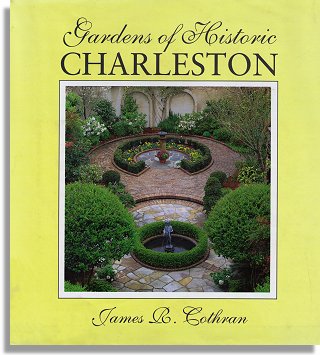
University of South Carolina Press (1995). 177pp. 9.25 x 9.25 inches. Hardcover. ISBN-10: 1-57003-004-9. ISBN-13: 978-1-57003-004-8.
Affectionately known as “a city set in a garden,” Charleston has been revered for its fine gardens since colonial times. While magnificent plantation gardens such as Middleton and Magnolia grace the outskirts of the city it is the small private gardens that endow Charleston with its distinctive character and old world charm. Passersby spy these half-hidden sanctuaries through wrought-iron gates and vine-covered walls; they glimpse the piazzas, statuary fountains, cobblestone walks, and seasonal plants that have transformed narrow spaces into enchanting outdoor rooms. Gardens of Historic Charleston invites readers to venture beyond these garden gates, experiencing both the allure and seclusion of the city's celebrated town gardens.
James R. Cothran, a landscape architect who has been fascinated by Charleston gardens for more than four decades, recounts the history of horticulture in the city where small-space gardening has reached the zenith of refinement and ingenuity. He guides readers through some of its most cherished private retreats, including a refuge inspired by The Secret Garden and the much-visited garden at the historic Heyward-Washington House, where George Washington stayed while in the port city. Cothran explains the principles inherent in all Charleston gardening — integration of house and garden, maximum use of limited space, enclosure by protective walls, and the creative use of ornamental plants — as he suggests ways to apply these same techniques in one's own garden.
With the increasing interest in small-space gardening, Gardens of Historic Charleston provides a wellspring of ideas for planning or improving a garden of limited expanse. Using these ideas, individuals living in condominiums, townhouses, and cluster homes can create their own small-space sanctuaries and can incorporate the exotic plants that have become synonymous with historic Charleston — not only camellias and azaleas, but also tea olive, wisteria, star jasmine, gardenia, oleander, chaste tree, Lady Banksia rose, crape myrtle, and Carolina jessamine.
A native South Carolinian, James R. Cothran is a practicing landscape architect and urban planner in Atlanta, Georgia. He holds degrees from Clemson University, the University of Georgia, and the Georgia Institute of Technology where his academic training included ornamental horticulture, landscape architecture, and city planning. He also serves as adjunct professor in Georgia State University's Heritage Preservation Program where he teaches a graduate course on America's historic gardens and landscapes. A past president of the Georgia Chapter of the American Society of Landscape Architects and former member of the Atlanta Urban Design Commission and Tree Preservation Review Board, Cothran currently serves as a board member of Trees Atlanta and the Cherokee Garden Library. He is a member of numerous professional organizations including the American Society of Landscape Architects, the American Planning Association, and the Southern Garden History Society.
This website is sponsored by Mitchells Publications.